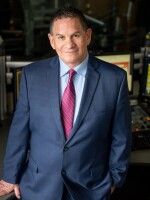A college class is in session but not in a classroom; it's in the mountains above Topanga Canyon.
As we walked down a rugged hillside, a group of Cal State Channel Islands students learns about the environment while helping to improve it.
"We've been cruising around all of the fire-impacted (Eaton and Palisades) areas, and we are doing some of our own projects, or plugging into existing projects," explained Cal State Channel Islands Professor Sean Anderson. "Today, we're working on a project managed by the Santa Monica Mountains Resource Conservation District. Working with State Parks here in Topanga State Park, we're servicing oaks that were planted in 2019."
Anderson and his wife created the program two decades ago when they joined the Camarillo-based university.
"Almost to the day when we started teaching, Hurricane Katrina happened," recalled Anderson. "Our school has a focus on a bunch of things we think are very important, like interdisciplinary community service. We created these mini-courses with university undergraduates from all across the campus. There's no major requirement; it's a pass/no pass class. Our sweet spot is that about six months after a disaster, we act like a free environmental consulting firm. But we don't start with that. We start with what people need. In some cases, it's giving out food, in some cases it's clearing weeds, and in some cases it's taking people to the doctor. It's whatever people need."
The program has conducted class trips to places like New Orleans for Hurricane Katrina relief efforts and Maui for wildfire relief projects.
Today, they're in the Santa Monica Mountains to survey and provide care for the young oak trees planted six years ago.

"Right now, we're working on oak restoration," said Nicole Kouyoumojian, a student in the program. "We're here checking to see if oaks that conservationists planted are still doing well. We're taking data to record that, and we're also watering them.
How are they looking?
"They are looking pretty good, said Kouyoumojian. "Every single one I've come across has been alive, and some are doing a little bit better than others."
"We're weeding the invasive plants, we're taking those out, and we're leaving the mulch that can keep water with the baby plants," said Max Morales, another student in the program.
The summer class had 40 student signups. But, at the last minute, the federal government cut a grant which helped pay for the project. Many students couldn’t afford to make up the difference. In the end, a dozen are taking part.
"We can talk about conservation, we can talk about wildfires, and we can talk about restoration in the classroom with PowerPoints, which is useful as an introduction," said Dr. Brenton Spees, an Assistant Teaching Professor at CSUCI. "But, getting them outside, carrying buckets of water, seeing the trees that are impacted, those are the lasting memories these students will carry with them. It's not these lectures or presentations that we do. This is the real education."
Gabriel Anderson is a recent Cal Poly San Luis Obispo graduate interested in environmental science. He is taking the class because he thinks it would be a way to do some good and learn along the way.
"It's been super fun, honestly," said Anderson. He spoke about working with Eaton and Palisades fire victims: "It's been really nice to do some fieldwork with restoration, helping these communities recover from the fires, but also hear firsthand accounts of experiences of the initial disaster, and how they've made things work since."
Among the projects the class is involved in is assessing the toxic cleanup from homes lost to the Eaton and Palisades wildfires, and testing the use of natural resources like mushrooms to help with the soil restoration.
"I remember when the (Southern California) wildfires were happening. We would talk about what was going on, and it really impacted them," said Dr. Timnit Kefela, another CSUCI professor involved in the program. "We had conversations about helplessness and not knowing what to do. Tying that lack of agency to an experience like this is empowering for the students." She added that they connect what the students learn in the classroom to helping people.
The students are learning by doing and making a difference, often doing work that might not happen because there’s no money for it. With a goal of going into fields like biology or environmental science, these students are thrilled to get some hands-on experience.



